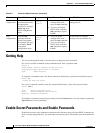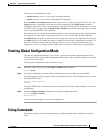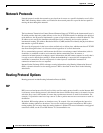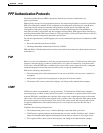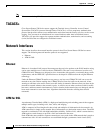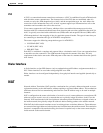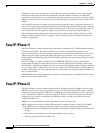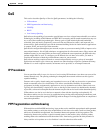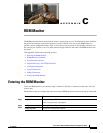
B-4
Cisco Secure Router 520 Series Software Configuration Guide
OL-14210-01
Appendix B Concepts
TACACS+
Note We recommend using CHAP because it is the more secure of the two protocols.
TACACS+
Cisco Secure Router 520 Series routers support the Terminal Access Controller Access Control
System
Plus (TACACS+) protocol through Telnet. TACACS+ is a Cisco proprietary authentication
protocol that provides remote access authentication and related network security services, such as event
logging. User passwords are administered in a central database rather than in individual routers.
TACACS+ also provides support for separate modular authentication, authorization, and accounting
(AAA) facilities that are configured at individual routers.
Network Interfaces
This section describes the network interface protocols that Cisco Secure Router 520 Series routers
support. The following network interface protocols are supported:
• Ethernet
• ATM for DSL
Ethernet
Ethernet is a baseband LAN protocol that transports data and voice packets to the WAN interface using
carrier sense multiple access collision detect (CSMA/CD). The term is now often used to refer to all
CSMA/CD LANs. Ethernet was designed to serve in networks with sporadic, occasionally heavy traffic
requirements, and the IEEE 802.3 specification was developed in 1980 based on the original Ethernet
technology.
Under the Ethernet CSMA/CD media-access process, any host on a CSMA/CD LAN can access the
network at any time. Before sending data, CSMA/CD hosts listen for traffic on the network. A host
wanting to send data waits until it detects no traffic before it transmits. Ethernet allows any host on the
network to transmit whenever the network is quiet. A collision occurs when two hosts listen for traffic,
hear none, and then transmit simultaneously. In this situation, both transmissions are damaged, and the
hosts must retransmit at some later time. Algorithms determine when the colliding hosts should
retransmit.
ATM for DSL
Asynchronous Transfer Mode (ATM) is a high-speed multiplexing and switching protocol that supports
multiple traffic types, including voice, data, video, and imaging.
ATM is composed of fixed-length cells that switch and multiplex all information for the network. An
ATM connection is simply used to transfer bits of information to a destination router or host. The ATM
network is considered a LAN with high bandwidth availability. Unlike a LAN, which is connectionless,
ATM requires certain features to provide a LAN environment to the users.
Each ATM node must establish a separate connection to every node in the ATM network that it needs to
communicate with. All such connections are established through a permanent virtual circuit (PVC).



